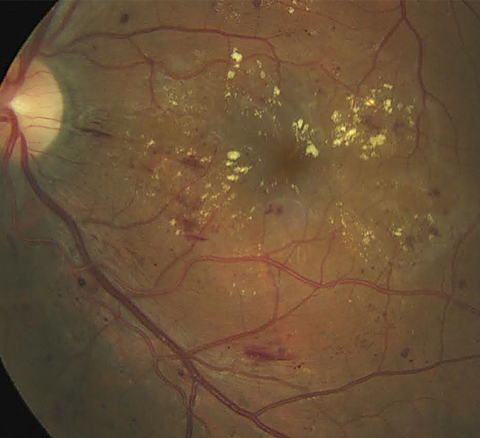 |
| Macular edema patients who have worse VA in the better eye may be more likely to have a lower quality of life. Photo: Erik Hanson, MD. Click image to enlarge. |
The visual changes wrought by macular edema in conditions such as diabetic macular edema, wet AMD and retinal vein occlusion cause many such patients to suffer from both decreased quality of life (QoL) and decreased vision-related quality of life (VrQoL). The treatment burden associated with macular edema is also high, as patients are subjected to long treatment duration and frequent intraocular injections.
A study recently investigated the demographic and clinical characteristics associated with and possibly predictive of QoL and VrQoL in patients with macular edema receiving anti-VEGF treatment to help identify those in need of additional supportive services such as low vision therapy. They found that the factor most significantly associated with lower VrQoL was worse visual acuity of the patient’s better eye.
The researchers assessed overall and vision-related QoL in a total of 712 patients at baseline, six and 12 months during anti-VEGF treatment. They used a 47-question evaluation called EyeQ to measure VrQoL. Quality of life was measured using the EuroQol Five Dimensions (EQ-5D) questionnaire. Other patient information collected as possible predictors included sex, age, marital status (single or not single), education (low or high), employment status and non-ocular comorbidities being treated or monitored.
The data analyses led the team to conclude that “worse VrQoL was predicted by poorer logMAR visual acuity of the better eye, female sex, single civil status, older age, longer length of anti-VEGF treatment at baseline and the presence of non-ocular and ocular comorbidities,” the researchers wrote in their study. They noted that in this study, it wasn’t feasible to analyze ocular comorbidities separately, so it’s unclear which ones specifically have an effect on VrQoL.
As for the characteristics associated with QoL, they found “suboptimal EQ-5D scores were predicted by poorer logMAR visual acuity of the better eye, female sex, single civil status, older age, the presence of non-ocular comorbidities and lower educational background.”
Visual acuity of the better eye is a key consideration during clinical decision-making when treating patients with macular edema. Based on this study’s findings, the researchers suggest keeping in mind that decreased visual acuity of the better eye may be predictive of both VrQoL and QoL in patients during anti-VEGF treatment.
Rausch-Koster PT, Rennert KN, Heymans MW, et al. Predictors of vision-related quality of life in patients with macular edema receiving intravitreal anti-VEGF treatment. Ophthalmic Physiol Opt. April 2, 2022. [Epub ahead of print]. |

